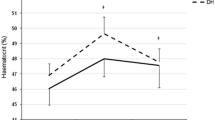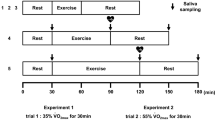Abstract
Purpose
Salivary antimicrobial proteins (sAMPs) protect the upper respiratory tract (URTI) from invading microorganisms and have been linked with URTI infection risk in athletes. While high training volume is associated with increased URTI risk, it is not known if fitness affects the sAMP response to acute exercise. This study compared the sAMP responses to various exercising workloads of highly fit experienced cyclists with those who were less fit.
Methods
Seventeen experienced cyclists (nine highly fit; eight less fit) completed three 30-min exercise trials at workloads corresponding to −5, +5 and +15 % of the individual blood lactate threshold. Saliva samples were collected pre- and post-exercise to determine the concentration and secretion of α-amylase, human neutrophil proteins 1–3 (HNP1–3) lactoferrin, LL-37, lysozyme, and salivary SIgA.
Results
The concentration and/or secretion of all sAMPs increased post-exercise, but only α-amylase was sensitive to exercise workload. Highly fit cyclists had lower baseline concentrations of α-amylase, HNP1–3, and lactoferrin, although secretion rates did not differ between the groups. Highly fit cyclists did, however, exhibit greater post-exercise increases in the concentration and/or secretion of a majority of measured sAMPs (percentage difference between highly fit and less fit in parentheses), including α-amylase concentration (+107 %) and secretion (+148 %), HNP1–3 concentration (+97 %) and secretion (+158 %), salivary SIgA concentration (+181 %), lactoferrin secretion (+209 %) and LL-37 secretion (+138 %).
Conclusion
We show for the first time that fitness level is a major determinant of exercise-induced changes in sAMPs. This might be due to training-induced alterations in parasympathetic and sympathetic nervous system activation.



Similar content being viewed by others
Abbreviations
- sAMP:
-
Salivary antimicrobial protein
- URTI:
-
Upper respiratory tract infection
- SIgA:
-
Secretory Immunoglobulin A
- HNP:
-
Human neutrophil peptide
- BLT:
-
Blood lactate threshold
- RPM:
-
Revolutions per minute
- RPE:
-
Rating of perceived exertion
- ANOVA:
-
Analysis of variance
References
Allgrove JE, Gomes E, Hough J, Gleeson M (2008) Effects of exercise intensity on salivary antimicrobial proteins and markers of stress in active men. J Sports Sci 26(6):653–661. doi:10.1080/02640410701716790
Bals R, Hiemstra PS (2004) Innate immunity in the lung: how epithelial cells fight against respiratory pathogens. Eur Respir J 23(2):327–333
Bartlett JA, Fischer AJ, McCray PB Jr (2008) Innate immune functions of the airway epithelium. Contrib Microbiol 15:147–163. doi:10.1159/000136349
Bishop NC, Gleeson M (2009) Acute and chronic effects of exercise on markers of mucosal immunity. Front Biosci (Landmark Ed) 14:4444–4456
Borg GA (1973) Perceived exertion: a note on “history” and methods. Med Sci Sports 5(2):90–93
Bourdon P (2013) In: Tanner RK, Gore CJ (eds) Physiological tests for elite athletes, 2nd edn. Human Kinetics, Champaign, pp 77–102
Bowdish DM, Davidson DJ, Hancock RE (2005) A re-evaluation of the role of host defence peptides in mammalian immunity. Curr Protein Pept Sci 6(1):35–51
Calvo F, Chicharro JL, Bandres F, Lucia A, Perez M, Alvarez J, Mojares LL, Vaquero AF, Legido JC (1997) Anaerobic threshold determination with analysis of salivary amylase. Can J Appl Physiol 22(6):553–561
Chatterton RT Jr, Vogelsong KM, Lu YC, Ellman AB, Hudgens GA (1996) Salivary alpha-amylase as a measure of endogenous adrenergic activity. Clin Physiol 16(4):433–448
Chen X, Niyonsaba F, Ushio H, Okuda D, Nagaoka I, Ikeda S, Okumura K, Ogawa H (2005) Synergistic effect of antibacterial agents human beta-defensins, cathelicidin LL-37 and lysozyme against Staphylococcus aureus and Escherichia coli. J Dermatol Sci 40(2):123–132. doi:10.1016/j.jdermsci.2005.03.014
Chicharro JL, Lucia A, Perez M, Vaquero AF, Urena R (1998) Saliva composition and exercise. Sports Med 26(1):17–27
Coote JH (2010) Recovery of heart rate following intense dynamic exercise. Exp Physiol 95(3):431–440. doi:10.1113/expphysiol.2009.047548
Dale BA, Tao R, Kimball JR, Jurevic RJ (2006) Oral antimicrobial peptides and biological control of caries. BMC Oral Health 6(Suppl 1):S13. doi:10.1186/1472-6831-6-S1-S13
Davison G, Allgrove J, Gleeson M (2009) Salivary antimicrobial peptides (LL-37 and alpha-defensins HNP1-3), antimicrobial and IgA responses to prolonged exercise. Eur J Appl Physiol 106(2):277–284. doi:10.1007/s00421-009-1020-y
de Oliveira VN, Bessa A, Lamounier RP, de Santana MG, de Mello MT, Espindola FS (2010) Changes in the salivary biomarkers induced by an effort test. Int J Sports Med 31(6):377–381. doi:10.1055/s-0030-1248332
De Smet K, Contreras R (2005) Human antimicrobial peptides: defensins, cathelicidins and histatins. Biotechnol Lett 27(18):1337–1347. doi:10.1007/s10529-005-0936-5
Dorschner RA, Pestonjamasp VK, Tamakuwala S, Ohtake T, Rudisill J, Nizet V, Agerberth B, Gudmundsson GH, Gallo RL (2001) Cutaneous injury induces the release of cathelicidin anti-microbial peptides active against group A Streptococcus. J Invest Dermatol 117(1):91–97. doi:10.1046/j.1523-1747.2001.01340.x
Doss M, White MR, Tecle T, Hartshorn KL (2010) Human defensins and LL-37 in mucosal immunity. J Leukoc Biol 87(1):79–92. doi:10.1189/jlb.0609382
Fahlman MM, Engels HJ (2005) Mucosal IgA and URTI in American college football players: a year longitudinal study. Med Sci Sports Exerc 37(3):374–380
Fahlman MM, Engels HJ, Morgan AL, Kolokouri I (2001) Mucosal IgA response to repeated wingate tests in females. Int J Sports Med 22(2):127–131
Fortes MB, Diment BC, Di Felice U, Walsh NP (2012) Dehydration decreases saliva antimicrobial proteins important for mucosal immunity. Appl Physiol Nutr Metab 37(5):850–859. doi:10.1139/h2012-054
Gellish RL, Goslin BR, Olson RE, McDonald A, Russi GD, Moudgil VK (2007) Longitudinal modeling of the relationship between age and maximal heart rate. Med Sci Sports Exerc 39(5):822–829. doi:10.1097/mss.0b013e31803349c6
Gillum T, Kuennen M, Miller T, Riley L (2014) The effects of exercise, sex, and menstrual phase on salivary antimicrobial proteins. Exerc Immunol Rev 20:23–38
Gleeson M (2000) Mucosal immunity and respiratory illness in elite athletes. Int J Sports Med 21(Suppl 1):S33–S43
Gleeson M, Pyne DB (2000) Special feature for the Olympics: effects of exercise on the immune system: exercise effects on mucosal immunity. Immunol Cell Biol 78(5):536–544. doi:10.1111/j.1440-1711.2000.t01-8-.x
Gleeson M, McDonald WA, Pyne DB, Cripps AW, Francis JL, Fricker PA, Clancy RL (1999) Salivary IgA levels and infection risk in elite swimmers. Med Sci Sports Exerc 31(1):67–73
Gleeson M, Bishop N, Oliveira M, McCauley T, Tauler P, Muhamad AS (2012) Respiratory infection risk in athletes: association with antigen-stimulated IL-10 production and salivary IgA secretion. Scand J Med Sci Sports 22(3):410–417. doi:10.1111/j.1600-0838.2010.01272.x
Hanson LA, Ahlstedt S, Andersson B, Carlsson B, Cole MF, Cruz JR, Dahlgren U, Ericsson TH, Jalil F, Khan SR, Mellander L, Schneerson R, Eden CS, Soderstrom T, Wadsworth C (1983) Mucosal immunity. Ann NY Acad Sci 409:1–21
Laube DM, Yim S, Ryan LK, Kisich KO, Diamond G (2006) Antimicrobial peptides in the airway. Curr Top Microbiol Immunol 306:153–182
Leicht CA, Bishop NC, Goosey-Tolfrey VL (2011) Mucosal immune responses to treadmill exercise in elite wheelchair athletes. Med Sci Sports Exerc 43(8):1414–1421. doi:10.1249/MSS.0b013e31820ac959
Li TL, Gleeson M (2004) The effect of single and repeated bouts of prolonged cycling and circadian variation on saliva flow rate, immunoglobulin A and alpha-amylase responses. J Sports Sci 22(11–12):1015–1024
Markkanen H, Syrjanen SM, Alakuijala P (1986) Salivary IgA, lysozyme and beta 2-microglobulin in periodontal disease. Scand J Dent Res 94(2):115–120
McCormick TS, Weinberg A (2010) Epithelial cell-derived antimicrobial peptides are multifunctional agents that bridge innate and adaptive immunity. Periodontology 54(1):195–206. doi:10.1111/j.1600-0757.2010.00373.x
Nater UM, Rohleder N (2009) Salivary alpha-amylase as a non-invasive biomarker for the sympathetic nervous system: current state of research. Psychoneuroendocrinology 34(4):486–496. doi:10.1016/j.psyneuen.2009.01.014
Neville V, Gleeson M, Folland JP (2008) Salivary IgA as a risk factor for upper respiratory infections in elite professional athletes. Med Sci Sports Exerc 40(7):1228–1236. doi:10.1249/MSS.0b013e31816be9c3
Nieman DC (2000) Is infection risk linked to exercise workload? Med Sci Sports Exerc 32(7 Suppl):S406–S411
Nieman DC, Henson DA, Dumke CL, Lind RH, Shooter LR, Gross SJ (2006) Relationship between salivary IgA secretion and upper respiratory tract infection following a 160-km race. J Sports Med Phys Fit 46(1):158–162
Orsi N (2004) The antimicrobial activity of lactoferrin: current status and perspectives. Biometals 17(3):189–196
Papacosta E, Nassis GP (2011) Saliva as a tool for monitoring steroid, peptide and immune markers in sport and exercise science. J Sci Med Sport 14(5):424–434. doi:10.1016/j.jsams.2011.03.004
Purvis D, Gonsalves S, Deuster PA (2010) Physiological and psychological fatigue in extreme conditions: overtraining and elite athletes. PM R 2(5):442–450. doi:10.1016/j.pmrj.2010.03.025
Putsep K, Carlsson G, Boman HG, Andersson M (2002) Deficiency of antibacterial peptides in patients with morbus Kostmann: an observation study. Lancet 360(9340):1144–1149. doi:10.1016/S0140-6736(02)11201-3
Raczak G, Danilowicz-Szymanowicz L, Kobuszewska-Chwirot M, Ratkowski W, Figura-Chmielewska M, Szwoch M (2006) Long-term exercise training improves autonomic nervous system profile in professional runners. Kardiol Pol 64(2):135–140 discussion 141-132
Radek K, Gallo R (2007) Antimicrobial peptides: natural effectors of the innate immune system. Semin Immunopathol 29(1):27–43
Sawka MN, Burke LM, Eichner ER, Maughan RJ, Montain SJ, Stachenfeld NS (2007) American college of sports medicine position stand. Exercise and fluid replacement. Med Sci Sports Exerc 39(2):377–390. doi:10.1249/mss.0b013e31802ca597
Steerenberg PA, van Asperen IA, van Nieuw Amerongen A, Biewenga A, Mol D, Medema GJ (1997) Salivary levels of immunoglobulin A in triathletes. Eur J Oral Sci 105(4):305–309
Tanida T, Okamoto T, Okamoto A, Wang H, Hamada T, Ueta E, Osaki T (2003) Decreased excretion of antimicrobial proteins and peptides in saliva of patients with oral candidiasis. J Oral Pathol Med 32(10):586–594
Tao R, Jurevic RJ, Coulton KK, Tsutsui MT, Roberts MC, Kimball JR, Wells N, Berndt J, Dale BA (2005) Salivary antimicrobial peptide expression and dental caries experience in children. Antimicrob Agents Chemother 49(9):3883–3888. doi:10.1128/AAC.49.9.3883-3888.2005
Tenovuo JO (1989) Human saliva : clinical chemistry and microbiology. CRC Press, Boca Raton
Tomasi TB, Trudeau FB, Czerwinski D, Erredge S (1982) Immune parameters in athletes before and after strenuous exercise. J Clin Immunol 2(3):173–178
Ueta E, Tanida T, Doi S, Osaki T (2000) Regulation of Candida albicans growth and adhesion by saliva. J Lab Clin Med 136(1):66–73. doi:10.1067/mlc.2000.107304
Usui T, Yoshikawa T, Orita K, Ueda SY, Katsura Y, Fujimoto S, Yoshimura M (2011) Changes in salivary antimicrobial peptides, immunoglobulin A and cortisol after prolonged strenuous exercise. Eur J Appl Physiol 111(9):2005–2014. doi:10.1007/s00421-011-1830-6
Walsh NP, Blannin AK, Clark AM, Cook L, Robson PJ, Gleeson M (1999) The effects of high-intensity intermittent exercise on saliva IgA, total protein and alpha-amylase. J Sports Sci 17(2):129–134. doi:10.1080/026404199366226
Weltman A (1995) The blood lactate response to exercise. Human Kinetics, Champaign
West NP, Pyne DB, Renshaw G, Cripps AW (2006) Antimicrobial peptides and proteins, exercise and innate mucosal immunity. FEMS Immunol Med Microbiol 48(3):293–304. doi:10.1111/j.1574-695X.2006.00132.x
West NP, Pyne DB, Kyd JM, Renshaw GM, Fricker PA, Cripps AW (2010) The effect of exercise on innate mucosal immunity. Br J Sports Med 44(4):227–231. doi:10.1136/bjsm.2008.046532
Zouhal H, Jacob C, Delamarche P, Gratas-Delamarche A (2008) Catecholamines and the effects of exercise, training and gender. Sports Med 38(5):401–423
Acknowledgments
This work was supported by NASA Grant NNX12AB48G to R.J. Simpson.
Conflict of interest
The authors declare no conflict of interest.
Author information
Authors and Affiliations
Corresponding author
Additional information
Communicated by Martin Flueck.
Rights and permissions
About this article
Cite this article
Kunz, H., Bishop, N.C., Spielmann, G. et al. Fitness level impacts salivary antimicrobial protein responses to a single bout of cycling exercise. Eur J Appl Physiol 115, 1015–1027 (2015). https://doi.org/10.1007/s00421-014-3082-8
Received:
Accepted:
Published:
Issue Date:
DOI: https://doi.org/10.1007/s00421-014-3082-8




